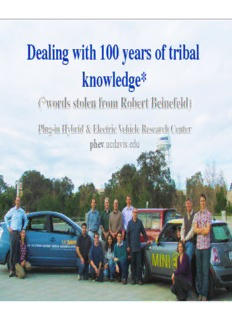
ARPA-e .pptx PDF
Preview ARPA-e .pptx
Dealing with 100 years of tribal knowledge* phev.ucdavis.edu PH&EV Center Research teams and research partners Consumers Fleet Battery studies Spatial & Human Machine Development Temporal PEV Interfaces • Lifestyle studies • Benchmark Testing Energy Use • Market demand • Market Segments • 2nd use • Response to HMI • Usage patterns • Fleet Operation • End of life • GIS analysis design • CEC, BMW, ARB • Energy Savings • DOE, NREL, • Charging network • Benchmarking • Chrysler, DOE Aerovironment, UCB, design • ARB, ORNL, CEC UCSD, SDGE • CEC, Nissan, INL, ECOtality Dr. Kurani Dr. Nesbitt Dr. Burke Dr. Nicholas Dr. Stillwater & Dr. Tal Beginning to compare regions & cities trying to make PEVs happen 1. Partnership: International Energy Agency, Clean Energy Ministerial Electric Vehicle Initiative,(16 Energy Ministries), Clinton 40, Rocky Mountain Institute, PH&EV Center 2. WECE Website 20-24 cities, data sharing, project showcasing 3. WECE Conference Los Angeles May 5 2012 Amsterdam, Shanghai, Stockholm, Barcelona, Lisbon, Shenzhen, Tokyo, Hamburg, Victoria, Portland, San Diego, Los Angeles Automobility • 100 year system of petroleum, internal combustion, roads. • Important practical and lifestyle tool, mobility, public symbol of household success. • 100 years of “tribal knowledge” of users, makers, etc.. • World total fleet 6-700 million / World Annual Sales 75 million • Many brands, types, 100s of models, brutally competitive, big investments • Slow turnover (10-15 years) –saturation and declining sales in US, Japan, Europe..first buyer sales in China, India, Eastern Europe, South America Buyers are confronted with new, complex choices • Driving range & refueling: • PHEV dual fueled, 20-100 km of EV Difficult choices range, blended designs • BEVs – big range of ranges 50-300 km when full discharged • Electricity: costs ($.03-.30 kWh), dashboard displays, sounds; drive feel; plug in where they park, • Vehicle uncertainty: safety, batteries, durability, cold and hot climates, will people think I’m smart? • Complex social & environmental benefits: • Greatly reduce petroleum use; • Zero tailpipe for BEV, • GHG emissions vary by regions Chasm Theory proposes innovations often get stuck in the “Valley of Death” Main market “Settlers” - more Early market / price sensitive, Explorers and fearful??? Pioneers Valley of death Development of market Did HEVs cross the chasm in Japan? Why is the Prius the best selling vehicle in Japan? (since 2009, 35,000-7% of sales in Feb 20112 20,500 12th in US) • About $100,000 yen/ $1100 incentive • Public values and knowledge were developed Why are 50% of US Leaf & Volt sales in California/ • Price of vehicle is lower? More affluent? • Price of gas is higher? Lower price of electricity? • More incentives to buyers? (rebates, tax credits, HOV lanes, free electricity/ parking?) • EV ready? (charge system in place?) • Regulations? (ZEV program) • Tree huggers..liberals..techies.. • 5 times as many innovators? In 1090s, Tom and Ken study potential buyers of EVs, some buyers of CNG • Tom & Ken ..1990s: focus on practical decisions of fleets, pioneers, probable buyers of CNG, diesel, EVs, PHEVs, about range, refuel/recharge, low speed EVs, “city “ EVs. Concept of range elusive without direct experience, households talk about “critical” trips, routine activity space, safety buffers, main market is probably “hybrid households” • Buyers not interested in CNG, Methanol unless it saves money. • EV driving experience and concept of using electricity as fuel has some spark
Description: